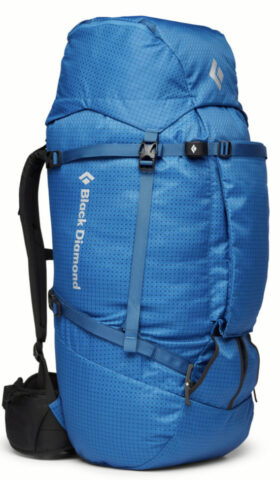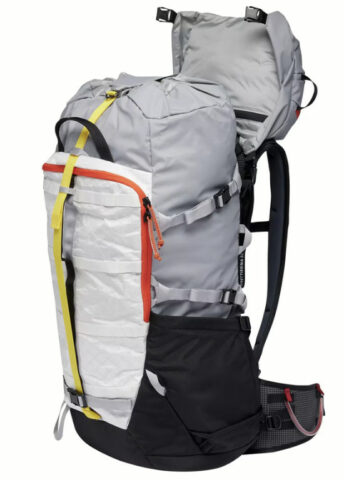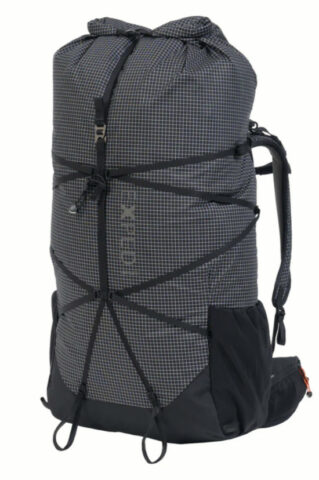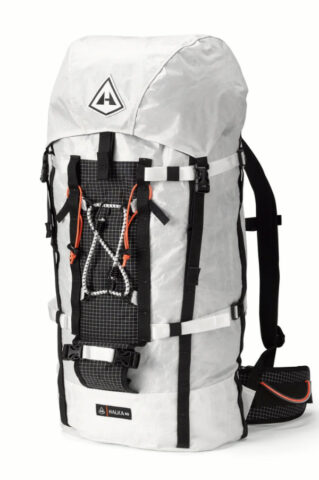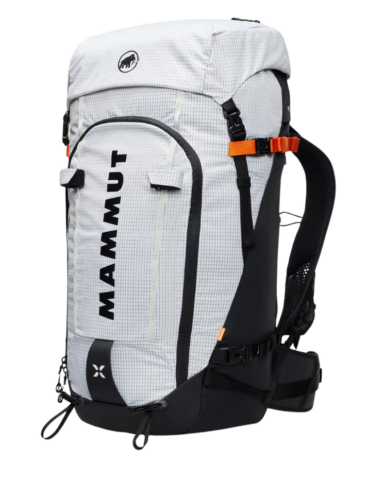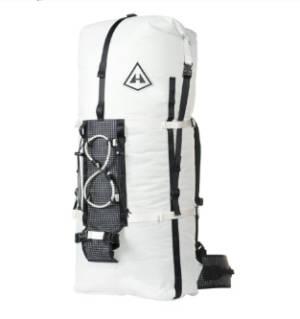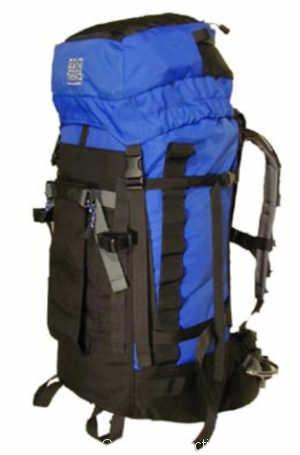Mountaineering and Winter Backpacking packs are more specialized than regular three-season backpacks, with a stronger emphasis on heavier weight loads, external attachment points, and durability for carrying bulky gear with sharp points like snowshoes, skis, ice axes, and crampons. They also favor more pockets and the ability to access and put away gear quickly, so you can avoid standing around between gear transitions and getting cold. Pack volumes can vary anywhere from a minimum of 50L to 80L.
Here are our picks for the top 10 best mountaineering and winter backpacks:
1. Osprey Mutant 52L Backpack
The Osprey Mutant 52 packs a wealth of great features into a mountaineering and climbing backpack. It has a floating lid, wand, and ski carry system, a hipbelt with gear loops, daisy chains, ice tool, and shaft holders, and a helmet attachment option. The top lid and hip belt are also completely removable to save weight or for use with a climbing harness. Priced at $230 (a steal), the 52 oz Osprey Mutant 52 is a great winter backpack for fast-and-light or hut-to-hut trips where you can streamline your gear list. We also recommend the smaller volume
Osprey Mutant 38 for winter day hiking or ice climbing.
2. Hyperlite Mountain Gear Ice Pack
The Hyperlite Mountain Gear Ice Pack is a winter backpacking and mountaineering pack made with ultralight Dyneema DCF fabric, which doesn’t absorb water and is very durable. It gracefully combines a minimalist sensibility with a roll-top and has an integrated crampon pocket, hip belt gear loops, numerous external attachment points, and daisy chains. A reinforced back panel is provided to haul heavier loads. Hyperlite sells this pack in 70L, 55L, and 40L volumes. The 40L volume makes a good winter day hiking and peak bagging pack.
3. Black Diamond Mission Backpack
The Black Diamond Mission is a top-loading, mountaineering backpack with a floating lid, front crampon pocket, hip belt loops, and a full-length side zipper for easy gear access. It is fully strippable with a removable waist belt, lid, and framesheet. A metal dogbone ice tool attachment provides a secure attachment for technical ice tools and mountaineering axes, while a tuck-away rope strap secures even more gear to the outside. The mission is available in 70L and 55L volumes and made with 420d ripstop nylon fabric with a UTS coating for bomber durability.
4. Mountain Hardware Direttissima 55
The Mountain Hardwear Direttissima 55 is a versatile top-loading mountaineering backpack with an adjustable torso length, which is rare in alpine backpacks. It has a floating lid with three secure zip pockets, a removable crampon pocket, rope carry, reinforced webbing haul loops on the hip belt for pulling sleds, and an A-frame and diagonal ski carry. There is also a large zippered front pocket for storing avalanche tools, side pockets to secure alpine essentials like tent poles, pickets, and wands, and wrap-around compression straps to lash gear to the outside of the pack. The pack is made with a 210d nylon ripstop with an 840d nylon base capable of withstanding anything you can throw its way.
5. Cold Cold World Chaos Backpack
Chances are you’ve never heard of Cold Cold World Backpacks before, but their packs are famous in the mountaineering and search and rescue communities.
The Chaos is a frameless, top-loading backpack with a floating top lid, front crampon pocket, ski loops, gear loops on the hip belt, dual ice ax loops w/ shaft holders, and multiple daisy chains so you can lash gear to the outside of the pack. It has an internal sleeping pad pocket so you can use a foam pad as a frame. Custom fabrics and colors are also available on request. A stock Chaos weighs in at just 3 lbs 12 oz, which is quite respectable for a pack that’s this technical and durable.
Read our Chaos Review.6. Cilogear MOB Worksack
The Cilogear MOB Worksack is a versatile climbing and mountaineering backpack favored by guides worldwide because it is fully featured and flexible to use. It has a removable framesheet with an aluminum stay, a bivy pad, a crampon pocket, a removable lid, a sternum belt, and a hip belt. The strap set consists of four short simple straps, two long simple straps, two dual adjust side release straps that go all the way around the pack, and two long side release straps that allow you to strap all kinds of awkwardly sized winter gear to the outside. The pack is available in 45L, 60L, 80L sizes. Get ready for sticker shock on this one.
7. Exped Lightning
The Exped Lightning is a versatile trekking pack with DNA suitable for light-and-fast mountaineering objectives. It is a roll-top pack with an adjustable torso length with numerous external attachment points for securing bulky mountaineering gear from technical or walking axes to rope and tent bodies. It has two side stretch pockets capable of holding tent poles, pickets, and wands and includes glove-friendly hardware so you can adjust without exposing your hands to the cold. The Lightning is available in two volumes, a 60L and 45L model.
Read the SectionHiker review.
8. Hyperlite Mountain Gear Halka Backpack
The Hyperlite Mountain Gear Halka is a waterproof Dyneema DCF mountaineering backpack with a floating top lid pocket, gear loops on the hip belt, and numerous attachment points for hauling bulky alpine gear. It has a dual ice axe pick pocket & figure-8 crampon attachment numerous external daisy chains, and a strippable hipbelt for use with a climbing harness. If your aspirations reach 8k heights, there’s even an internal daisy chain to secure an O2 bottle. The Halka is available in 55L and 70L models.
9. Mammut Trion 50
The updated Mammut Trion 50 is a rolltop backpack with an optional floating top lid pocket and vest-style shoulder straps with external mesh pockets. It has rear full zipper access to the main compartment and a separate pocket for avalanche safety equipment, a detachable hip belt, side ski carry, and trekking pole and ice axe holders.
10. Granite Gear Blaze 60 Backpack
The Granite Gear Blaze 60 is a great roll-top backpack with an optional top lid and front zippered access to the main compartment. Weighing just 48 oz, it has an adjustable torso length and an adjustable size hip belt, with a rigid frame carrying 50+ lb loads with ease. Numerous compression straps make it easy to attach snowshoes or a foam pad to the outside of the pack or to haul ice tools, ropes, and avalanche rescue gear.
A women’s Blaze 60 with gender-specific shoulder straps and a hip belt is also available.
Read our Review.
How to Choose a Mountaineering/Winter Backpack
Backpacks tailored for mountaineering and winter backpacking use have a different feature set than most 3 season packs. What follows are the features that I’ve found most useful for winter trips in mountainous terrain. While I think these translate fairly broadly across winter locales, you need to be the judge on the features you believe are most relevant for your needs.
Volume and Weight
If you mostly plan on doing weekend-length cold-weather trips, you’ll probably want a pack that has 55-80 liters of internal capacity. The sweet spot is about 70 liters, but you might be able to shave that down as low as 50 liters if you carry less gear or need less insulation. Try to get a pack that has adequate compression so you can shrink its volume if not needed while keeping the weight of an empty pack under 5 pounds. Pack and gear weight is even more important in winter conditions than the rest of the year because you’ll be wearing and carrying a lot more of it.
External Attachment Points
Mountaineering and winter backpacking packs need to have many external attachment points to carry sharp, pointy, or bulky gear that won’t fit inside the main storage areas of a backpack. The most useful external attachment points include compression straps, daisy chains, hip belt webbing or gear loops, and ice ax loops with shaft holders.
Compression Straps
Compression straps serve two purposes: to help compress a puffy load and bring the weight closer to your core muscles where it can be carried more easily; and to attach sleeping pads, snowshoes, avalanche shovels, or skis to the sides of your pack instead of the front, so that the load doesn’t pull you backward and off-balance.
When choosing a backpack, try to find ones that have two or three tiers of compression straps that run horizontally across the sides of the packs. The compression straps should be adjustable and easy to undo while wearing gloves so you can slide winter tools under them. Avoid packs that have compression straps that zig zag back and forth on the backpack using one strap to save weight. These are very difficult to use, especially when wearing gloves.
Daisy Chains
Daisy chains are often sewn onto mountaineering and winter packs and can be used to lash extra gear to the back or sides of the pack using canvas or velcro straps. They usually have many loops sewn into them that run the length of your pack from top to bottom.
Ice Ax Loops
There are two kinds of ice axes in this world – straight walking axes and curved climbing axes. If you need to carry a walking ax, look for a pack that has at least one ice ax loop at the base of the pack and a shaft holder, both off-center along the back of the pack. The shaft holder can be a simple cord lock like those found on many Osprey packs, or a more robust buckle. If you plan on carrying two climbing axes, look for packs with two ice ax loops and shaft holders.
Hip Belt Webbing and Gear Loops
Some climbing-oriented packs have canvas or plastic gear loops on the outside of the hip belt to clip climbing carabiners to. While not a substitute for a proper sit-harness, these loops can be quite convenient to rack climbing gear.
Crampon Pockets
Crampon pockets are a convenient and safe place to store crampons when you’re not wearing them. Located on the side of the pack farthest away from you, they keep the crampon points away from your arms and legs, your head, and your gear where they can do real damage.
Floating Lids
It can be very helpful in winter to have a backpack that can expand in volume to carry more gear. One way to do this is to buy a pack with a floating lid, usually a top pocket that can detach from the main body of the pack but is still held down by 4 straps. Extra gear, say a coil of rope, can be sandwiched between the pocket and the top of your pack in this manner.
Zipper Access
Zipper access to the front or side of the backpack is a highly desirable feature for winter use because it makes for much faster stops, eliminating the need to pop open a top lid and dig around your backpack looking for gear You don’t want to stand around for very long on winter trips, but to get moving so your body can generate heat to stay warm.
SectionHiker is reader-supported. We only make money if you purchase a product through our affiliate links. Help us continue to test and write unsponsored and independent gear reviews, beginner FAQs, and free hiking guides.

